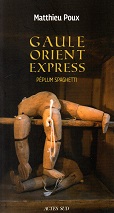A lire, pour ceux qui le peuvent, un superbe article sur la tonsure celtique dans le numÃĐro de Juin de la revue anglaise Antiquity.
J'ai copiÃĐ directement de leur site les paragraphes introductifs:
Message d'origine
The Venerable Bede, druidic tonsure and archaeology
Natalie VenclovÃĄ
Dr VenclovÃĄ is well known to readers of Antiquity as the excavator of the site of MseckÃĐÃĐ Zehrovice in Bohemia, find-place of the most famous example of Iron Age human representation. What she presents here is a provocative theory â that the MseckÃĐ Zehrovice stone head represents a Celtic druid!
Key words: Iron Age, Early Christian, Europe, druids, tonsure
Celtomania instead of cultural introduction
We continue to be persuaded by politicians that a unifying idea is needed for modern Europe. Indeed, many attempts have been made to find such an idea. Politicians apparently are not aware of the fact that Europe has for some time already been united by a widespread phenomenon â that, perhaps somewhat unkindly, termed Celtomania, accompanied by a widely shared idea that what the Europeans have in common are, among other factors â or rather, first of all â Celtic roots. It is typical that the confusing and confused recipe has little in common with history or archaeology: suffice that it is something unusual, romantic, added to which is a dash of adventure and a pinch of mysticism. The Celts are acceptable in many aspects and many nations can consider them their ancestors. What consequences it has, including the nationalistic ones, is another matter (see Dietler 1994 and the subsequent debate in ANTIQUITY: Megaw et Megaw 1996; Collis 1997). For those parts of Europe separated unwillingly from western civilization for some 40 years in the second half of the 20th century, moreover, their âCelticâ past means something which associates them with western Europe.
A necessary part of Celtomania is druidism and the druids, and readers might think that this paper is just the latest in a tradition stretching from William Stukeley to AstÃĐrix the Gaul. On the contrary, the present theme was inspired directly by a man who lived in Bohemia, once home of the undoubtedly Celtic tribe of the Boii, not far from the present village of MseckÃĐ Zehrovice some 50 km west from Prague in the Czech Republic, possibly in the 3rd century BC. His face, carved in local stone, has became one of the best-known examples of La TÃĻne art.
The issues presented here concerning the archaeological context of the sculpture are based on archaeological excavations conducted by the author in 1979â88 in the Viereckschanze or rectilinear enclosure at MseckÃĐ Zehrovice in the vicinity of the findplace of the stone head (VenclovÃĄ 1998 with refs.). ANTIQUITY readers have already had the occasion to get acquainted with the site and sculpture (Megaw et Megaw 1988; VenclovÃĄ 1989) but perhaps not with new material which offers not only new insights into the significance of the finds, but also an alternative model for the interpretation of the famous stone head itself.
It is not the aim of this paper to repeat what has been written by the ancient authors on the druids, and what has many times been analysed by archaeologists, historians and linguists (cf. Piggott 1968; Mac Cana 1991; Ryan 1992; Brunaux 1996; Birkhan 1997 with refs.).
An opinion has recently been expressed that there was an evolution within the priestly class and that the druids had their predecessors â for example, assistants in sacrifices â who did not posses all the intellectual abilities ascribed to the â later â druids (Brunaux 1996). It has also been argued that the term druides was perhaps introduced by Caesar in Book VI of De bello Gallico as the Gallic equivalent to the Roman senatus or principes, and that they represented an oligarchical ÃĐlite with both judicial and religious duties (Dunham 1995: 113â15). Certainly, some of their functions, including ritual ones, are presumed to have been supplanted by the later paramount chiefs (Creighton 1995). In sum, in the Iron Age, the druids took part in most diverse activities in the spheres of ritual and religion, law, education and politics. They belonged undoubtedly to the intellectuals within the ÃĐlite.
For years, researchers have tried to identify druids and their deeds in the archaeological record. In spite of their multiple roles, druids have most often been associated mainly with religion, and therefore their presence was sought at the loci considered to be sanctuaries or other ritual areas. In his book on druids, Stuart Piggott (1968) devoted the larger part of his chapter entitled âThe Celtic world of druidsâ to what he called the âarchaeology of Celtic religionâ, i.e. to shrines and temples, sacred enclosures, ritual shafts, votive deposits, cauldrons, funerary ritual and images; it was Piggottâs conviction that the druids were inseparable from ritual and religion.
At this point, three questions emerge: first, can sacred place be easily recognized; secondly, cannot the traces of druidic presence be found also in other than sacred places; and thirdly, what could indicate their presence in the archaeological record?
These are the opening paragraphs only of this article in 'Antiquity'. For the full text with illustrations see the journal itself.
ANTIQUITY 76 (2002): 458â71
Les illustrations sont remarquables et tendent à bien montrer qu'il a existÃĐ plusieurs types de tonsures chez les peuples celtes de l'antiquitÃĐ, et que ces tonsures sont les mÊmes que l'on retrouve dans le christianisme celte du haut Moyen Age.
A+
Patrice







